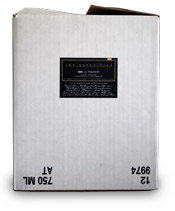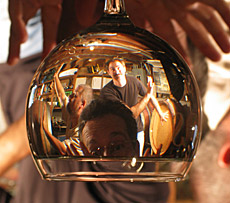Winehenge
In ancient times, before history like even started, a totally ancient race of dudes used dry ice to delay fermentation and increase the exposure of skins to juice. This is, like, their story?
No commentsPutting a cork in 2006
 Somewhere around 10pm last night, we stretched the last label over the last bottle of 2006 Peugeot, drawing to a close that plucky vintage. It’s kind of like putting the last fin-fold on a paper airplane and then flicking it into space — it could crash, it could sail, but aside from the momentum you put into the construction and the toss, its destiny is now pretty much out of your hands.
Somewhere around 10pm last night, we stretched the last label over the last bottle of 2006 Peugeot, drawing to a close that plucky vintage. It’s kind of like putting the last fin-fold on a paper airplane and then flicking it into space — it could crash, it could sail, but aside from the momentum you put into the construction and the toss, its destiny is now pretty much out of your hands.
Based on what I tasted last night, though, I think it’ll float on the breeze quite elegantly for a while. Into a holding tank, we siphoned half of each of the barrels we’d put the blend into back in the fall, and then added half of the stainless steel container that held the rest of the blend. After bottling that, we siphoned what remained in each of those containers into the tank, bottling until the last dregs dripped through the hose. A pain in the ass, but the idea behind it was that each barrel probably evolved a little differently over the last 7 months, so bottling them one after the other would result in different wines. More critically, the wine stored in the stainless — because it had no further oak exposure after blending — was indeed tighter, so it at least had to be spread around.
We’d never bottled this much wine at one sitting, so while we knew it would be a slog, we didn’t really know how much of one. A few volunteers came early to think through the system, get it set up, and begin the first blend into tank, and then the full complement came a few hours later at 3. While the two blends into tank added to the time, it was, as always, the labeling that took for-effing-ever. We’ve got to figure out a better way to do that. If George hadn’t requested his cases come un-labeled, we might still be sticky with glue.
All in all, though, I think it was worth it. The Peug was remarkably fragrant in the tank, and it laid gracefully in the mouth with lovely ripe fruit, subtle tannin, and a good spine of acidity. Before we added the first portion from the stainless, it tasted round, full, and ready to slide down the gullet; after the tighter product from the stainless, it clenched up again, but it says to me that after a year or so, this one should be exceptionally lovely. That’s borne out by the 2005 Peug, which blossomed about 3 years out.
Mmmmmm… when is 2009 again? Pics from bottling after the break…
Read more
The rack: March edition
 Last week’s racking proceeded with our characteristic machine-like efficiency – when we used our machines, that is.
Last week’s racking proceeded with our characteristic machine-like efficiency – when we used our machines, that is.
The Cabernet Sauvignon continues to shine. Great fruit, good tannins which are getting better with every racking (I’ll bet from the wood — see here for our oak strategy this year), transporting aromas of pencil shavings and saddle. This one’s going to be the best Cowan by far.
Next up was the Merlot. It seemed its usual, uncomplicated and amiable self at first, but lurking around the periphery — like the sense you get walking into a familiar room which looks empty, but has someone else inside — was an off odor. It’s a slight tint of VA (or volatile acidity, which betrays a lovely smell of fingernail polish), but there was also a hint of vegetation. A bit of veg can be typical of Merlot’s flavor profile, but this felt ever so slightly beyond that. After racking, everything seemed fine – no VA, no significant veg, and nice fruit. I measured the free SO2 at about 65, which seems safe enough, so no further additions. We’ll want to keep an eye on this one, though.
Lastly, we tasted the Cabernet Franc, which seemed just fine where it was — good, approachable structure, lovely, bright fruit. So we decided to simply top the barrel and leave the racking for the next go-around in April.
No commentsLet’s do some more numbers
Just got back the juice panel analysis of the cabernet sauvignon we picked last Saturday:
brix 24.1 degrees glucose + fructose 25.5 g/100mL pH 3.57 titratable acidity 0.54 g/100mL tartaric acid 3.71 g/L L-malic acid 3.06 g/L potassium 1760 mg/L alpha-amino compounds 76 mg/L ammonia 65 mg/L yeast assimilable nitrogen 130 mg/L (as N)
Considering other Eastern Washington fruit we’ve picked over the years, that acidity is about as perfect as you can get, and that pH is positively robust. Good structure, good health. The only minor worry is the last number, but we can easily add nutrients to the must to compensate.
All in all, pretty perfect numbers! Now all we have to do is not screw it up!
No commentsSon of Road Trip: the Cabernet
 Just a little after 6am, Whit and I unlocked the Flexcar truck, stowed tarps and tie-downs in the back, and headed east through foggy, deserted streets. The chill was penetrating, but in that autumnal way that betrays a certain lack of conviction: soon enough, it would dissolve into a warm, Indian summer day.
Just a little after 6am, Whit and I unlocked the Flexcar truck, stowed tarps and tie-downs in the back, and headed east through foggy, deserted streets. The chill was penetrating, but in that autumnal way that betrays a certain lack of conviction: soon enough, it would dissolve into a warm, Indian summer day.
A few miles past Hood River, the sun began to slice through the mist and dispel it back up into the hills, lifting a cascade of blue-monochrome buttes into view down the Gorge. By the time we crossed the Columbia and pointed north, the sun had cleared the way for a perfect grape run into the Yakima valley.
 The grower had already picked a few thousand pounds for us and another guy who arrived just moments later. My spot test with the refractometer, trying to pick a random assortment of berries, pegged the sugar somewhere between 23 and 27 – pretty ripe at the upper register, maybe just shy of ripe at the bottom. Any harvest short of Château d’Yquem‘s berry-by-berry picking regimen will have this kind of variation: you just hope the spread is relatively tight and the average is where you want to be. So if this really netted us 25 brix, we wouldn’t complain.
The grower had already picked a few thousand pounds for us and another guy who arrived just moments later. My spot test with the refractometer, trying to pick a random assortment of berries, pegged the sugar somewhere between 23 and 27 – pretty ripe at the upper register, maybe just shy of ripe at the bottom. Any harvest short of Château d’Yquem‘s berry-by-berry picking regimen will have this kind of variation: you just hope the spread is relatively tight and the average is where you want to be. So if this really netted us 25 brix, we wouldn’t complain.
Read more
Fermentation has begun!
Whit and I checked the Merlot late last night and it looks like we have ignition! The cap was just tentatively beginning to rise, and when Whit punched it down, the yeasts bubbled happily through the grape goo.
Then, this morning, I checked the Franc to discover that it has also decided to follow in its brother’s footsteps, so we’re firing on both cylinders. That means a steady regimen of punching down the cap, keeping track of sugar levels and temperature, and coming home every day to a house filled with beautiful fragrance.
Life is good!
No commentsLet’s do the numbers
 Got the numbers back from ETS, and as we guessed from the taste of the grapes, the Merlot should have been picked earlier. The upshot is that we’ll need to strap the Merlot to the treadmill and tone it up a bit, adding some acid to drop its pH into healthier territory and sharpen its fruit, and perhaps add some water to pull the potential alcohol down into balance.
Got the numbers back from ETS, and as we guessed from the taste of the grapes, the Merlot should have been picked earlier. The upshot is that we’ll need to strap the Merlot to the treadmill and tone it up a bit, adding some acid to drop its pH into healthier territory and sharpen its fruit, and perhaps add some water to pull the potential alcohol down into balance.
The Franc looks a lot better, but like the Merlot, will need to be monitored through the ferment because of their low yeast assimilable nitrogen content (or more colorfully, YANC). That potentially soporific term essentially characterizes how much nitrogen the yeast have to feed on to keep themselves fit and healthy through the ferment. From a paper by the Food Science and Technology department at OSU:
If the levels of fermentable nitrogen are too low, the total cell biomass produced will be low, the yeast fermentation may be slow, and the fermentation may stop or `stick’ before all the fermentable sugar is utilized. Yeast under nutritional stress due to nitrogen deficiency may also produce hydrogen sulfide (rotten egg) and other sulfur compounds with offodors
So we’ll definitely be adding some yeast nutrient and tasty-sounding di-ammonium phosphate (DAP) to both of these ferments to keep the yeasts happy and healthy.
The complete numbers and some more comments after the jump…
